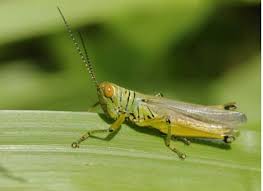16 New Grasshopper Species Discovered
Science & Technology TechnologyPosted by NewAdmin on 2025-02-10 09:06:54 |
Share: Facebook | Twitter | Whatsapp | Linkedin Visits: 74

A recent scientific breakthrough has led to the discovery of 16 new species of grasshoppers in the arid desert landscapes of the United States and Mexico. Mississippi State University entomologist Brandon Hill and his research team identified these species as part of the Agroecotettix genus, a group within the Melanoplinae subfamily. The findings, published in the journal ZooKeys, highlight the significant biodiversity of these dry ecosystems and emphasize the role of isolation and climate change in species evolution.
Hill suggests that these grasshoppers likely diverged during the Pleistocene Epoch, or Ice Age, as changing climates and glacial retreats created isolated habitats. The newly discovered species are unique in that they remain confined to specific mountain ranges, likely due to their selective mating behaviors and absence of premating rituals. This adaptation has allowed them to maintain stable populations despite environmental shifts.
To further understand their evolutionary history, researchers will analyze DNA from collected specimens at the University of Michigan. By using molecular clock techniques, they aim to determine when these species diverged and how past climate changes influenced their distribution. This information could also help predict the impact of future climate shifts on desert biodiversity.
This discovery is part of a broader effort to document North America's grasshopper diversity. Hill and his team are collaborating on multiple projects, including a comprehensive study on Melanoplinae diversity across North America and Mexico, sampling over 600 species. Their work is essential not only for biodiversity conservation but also for understanding how environmental changes drive species diversification. The study was funded by the National Science Foundation, Texas Ecolab, and the National Institute of Food and Agriculture.
Search
Categories
- Sports
- Business
- History
- Politics
- International
- Science & Technology
- Social Issues
- Disaster Management
- Current Affairs
- Education
- Startup Business
- Startup News
- Awards
- Community Services
- Fundraising Events
- Volunteer Services
- Health Initiatives
- Innovations and Initiatives
- In News
- dummybanners
- Awards
- Partners
- Products
- Press Releases
- News
- Fast Check
- South
- సినిమా
- Gallery
- Sunday Chronicle
- Hyderabad Chronicle
- లైఫ్ స్టైల్
- National
- క్రైం
- ట్రెండింగ్
- జాబ్స్
- అంతర్జాతీయo
- బిజినెస్
- రాజకీయం
- బిజినెస్
- సంపాదకీయం
- నవ్య
- చిత్ర జ్యోతి
- క్రీడలు
- జాతీయం
- తెలంగాణ
- తాజా వార్తలు
- మన పార్టీ
- మన నాయకత్వం
- మన విజయాలు
- డౌన్లోడ్స్
- మీడియా వనరులు
- కార్యకర్తలు
- North East Skill Center News
- Government Schemes
- Entrepreneurship Support
- Employment Opportunities
- Skill Training Programs
- Departments
- Investments
- Initiatives
- Resources
- Telangana IT Parks
- Events & Jobs
- Press Releases
- News
- Airport News
- Newtons Laws of Motion
- Karbonn in Business
- Investments in Karbonn
- Company quarterly sales
- Markets
- Auto News
- Industry
- Money
- Advertisements
- Stock target
- Company Updates
- Stock Market
- Company Sales
- Staffing and HR
- Constituency Assembly
- General News
- Srikalahasti Temple
- Bojjala Sudhir Reddy
- Technology & Innovation
- Sports
- Business
- Products
- Industries
- Services & Trainings
- Tools & Resources
- Technology Integration
- Drug Seizures & Arrests
- Telangana Narcotics
- Law & Enforcement
- Rehabilitation
- Nationwide Drug Policing
- Nigeria Seizures
- Global Operations
- Drug Awareness
- Drug Enforcement Tech
- NCB Drug Seizures
- Judicial Crackdown
- India's Surveillance Tools
- Cross-Border Links
- Women Safety
- Cyber Crimes
- Drug Abuse
- Traffic & Road Safety
- Community Connect
- Public Safety Alerts
- Citizen Assistance
- Nellore City News
- Politics & Administration
- Events & Festivals
- Agriculture & Rural
- Business & Economy
- Health & Wellness
Recent News
- Former Vice President Jagdeep Dhankhar Not Yet Requested Official Residence Retainment
- Mopping Up Operations In Lok Sabha, Speaker Om Birla Calls For Introspection
- Last-minute disruptions mark final day of parliament's monsoon session
- Market regulator SEBI plans to extend equity derivatives tenure
- Stock Picks for February: YES Securities & Sharekhan Optimistic About These 5 Companies
- Ban On Real-Money Gaming: 45 Million People Lose Rs 20,000 Crore Each Year, Says Report
- From Porn To Cricket: How Garth Stirrat Rebounds From An Unorthodox Start
- Rift In Saaniya Chandhok's Family? Grandfather Accuses Son of Forgery And Fraud